Sketch of Public Policy Communion, October 2017
|
2017年10月份國政聯誼會縮影 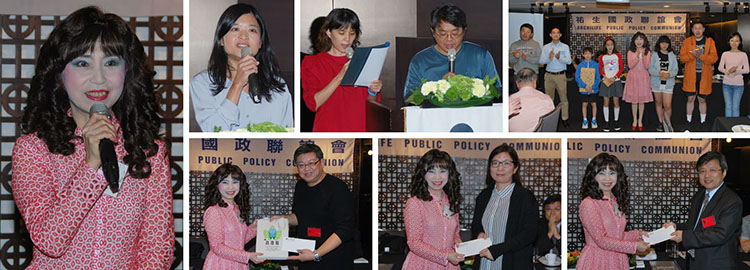 本會已於2017年10月29日假晶華酒店地下三樓晶英會舉行「祐生國政聯誼會」。在主持人黃晉英秘書長宣布後揭開當日活動序幕,在輕鬆、活潑的節目過後,隨即由主持人帶來重要訊息:「在氣候異變的影響下,外在環境瞬息萬變,提醒大家要掌握時機,做適當的事情。隨著數位化時代的來臨,使得「零工經濟」崛起,這些新興的共享經濟模式正表示著共生數位新文明的開展。另外,由近日日本神戶鋼鐵品質造假事件的新聞案例得知,維持始終如一的宗旨信念非常重要,提醒大家謹言慎行,做出正確的決策。」 The October Archilife Public Policy Communion of 2017 was held on October 29, 2017. After a series of relaxing and fun activities, Secretary General Huang Chin-ying made the following announcement, "Under the affect of climate change, I remind everybody to seize the correct moments to do appropriate things. In the face of the arrival of the digital age, the "Gig Economy" has emerged. These emerging sharing economy models represent the development of symbiotic digitalized new civilizations. Moreover, the recent news of the steel quality scandal in Kobe, Japan tells us that maintaining a consistent reputation is very important. I would remind everyone to be prudent in their words and behavior, while making proper decisions." 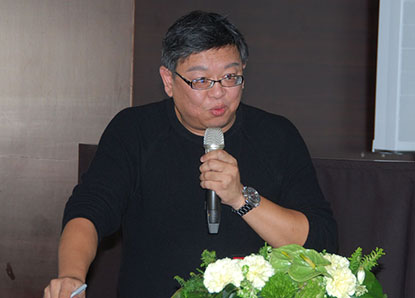 緊接著進行專題演講,由周伯丞先生主講「從國際交流參訪到地方建築政策推動」。主講人首先提到本年度參與之主要活動,除了擷取WSBE17 Hong Kong的活動主軸─「創新、整合」,在高雄國際綠建築暨建材大展的高峰論壇中,也提到永續共生的理念及智慧化健康照護。另外,亦前往日本大阪零碳建築技術參訪,探討生活面的應用以及舊建築的更新活化。接著在環亞熱帶創新低碳綠建築國際論壇中,也提到永續設計的手法。在活動參與過程中,瞭解到氣候異變是不可逆的現象,以及全球暖化導致永凍層融解、二氧化碳釋出等問題,提醒大家予以重視。 緊接著進行專題演講,由周伯丞先生主講「從國際交流參訪到地方建築政策推動」。主講人首先提到本年度參與之主要活動,除了擷取WSBE17 Hong Kong的活動主軸─「創新、整合」,在高雄國際綠建築暨建材大展的高峰論壇中,也提到永續共生的理念及智慧化健康照護。另外,亦前往日本大阪零碳建築技術參訪,探討生活面的應用以及舊建築的更新活化。接著在環亞熱帶創新低碳綠建築國際論壇中,也提到永續設計的手法。在活動參與過程中,瞭解到氣候異變是不可逆的現象,以及全球暖化導致永凍層融解、二氧化碳釋出等問題,提醒大家予以重視。Next on the schedule was the keynote speech. First, Mr. Chou Po-cheng, presented a speech on the "From International Exchange and Visiting to the Promotion of Local Construction Policy". The lecturer first mentioned the main events he participated in 2017. Besides stressing the event topic of "Innovation & Integration" from WSBE17 Hong Kong, he also mentioned the ideas of sustainable symbiosis and smart health care from the summit forum of Kaohsiung Green Architecture and Building Material Expo. Furthermore, he also visited the zero-carbon architecture technology of Osaka, Japan and explored its application in everyday life and the reactivation of old buildings. He then mentioned techniques on sustainable design at the International Forum on Innovative Low-Carbon and Green Buildings in Subtropical Area. While taking part in these events, he realized that climate change is an irreversible phenomenon, while global warming has caused problems such as the melting of permanent frozen layers and carbon dioxide emission, and reminds everyone to pay attention to these issues. 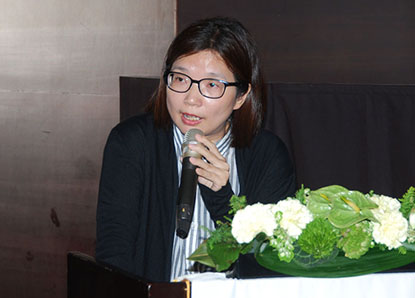 接著由國政會委員蘇美如小姐主講「文化資產保存案例分享─古蹟保存的關鍵點」。主講人首先說明文化資產之定義,並舉出實際案例:宜蘭市碧霞宮由於民眾關心及主政者重視,加上文資法修法,因而保留;頭城盧宅前池塘,原遭遇所有權人雇工填土之危機,因民眾通報反應及土地容積移轉之補償措施,使得重新修復;第一商業銀行宜蘭分行因居民提報及主管機關不放棄,而獲保留。私有古蹟享有許多權利,例如稅賦減免、維修補助及容積移轉等,唯仍有不得遷移﹑拆除或毀損之義務,期望能共同支持文化資產保存的推展。 接著由國政會委員蘇美如小姐主講「文化資產保存案例分享─古蹟保存的關鍵點」。主講人首先說明文化資產之定義,並舉出實際案例:宜蘭市碧霞宮由於民眾關心及主政者重視,加上文資法修法,因而保留;頭城盧宅前池塘,原遭遇所有權人雇工填土之危機,因民眾通報反應及土地容積移轉之補償措施,使得重新修復;第一商業銀行宜蘭分行因居民提報及主管機關不放棄,而獲保留。私有古蹟享有許多權利,例如稅賦減免、維修補助及容積移轉等,唯仍有不得遷移﹑拆除或毀損之義務,期望能共同支持文化資產保存的推展。Next, Ms. Su Mei-ju, spoke on "Case Study on the Preservation of Cultural Heritage: Key Points on Historical Site Preservation". First, The lecturer first mentioned the definition of cultural heritage and gave us practical examples. For example, Bixia Temple of Yilan City could be preserved through an emphasis on citizens and the administration, in addition to the amendment of Cultural Heritage Preservation Act. The pond in front of Lu's Residence at Toucheng was originally faced with the crisis of being filled up by workers hired by the property owner, but was preserved and repaired due to the notification of the citizens and bulk transfer compensation measures. The Yilan branch of the First Bank was also preserved due to citizen notification and the resilience of its authority. Although private historical sites enjoy many rights such as tax exemption, repairing subsidy, and bulk transfer, they still have obligations such as not being able to relocate, tear or destroy them. She expected that we could all support the promotion of cultural heritage preservation. 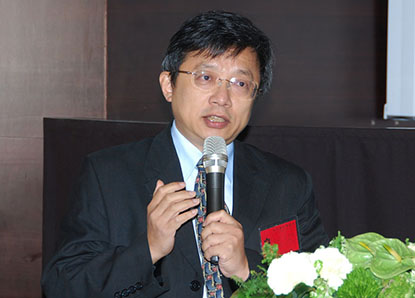 接著由國政會委員王文安先生主講「北緯13度與北緯31度的建築皮層觀察」。主講人首先說明本次題目是以屏東北緯22度正負9度來訂定,目前研究課題著重於南洋化下的氣候變遷調適策略,現象包括高溫、乾旱及強陣雨。從北緯1度新加坡、北緯13度曼谷及北緯31度中國江南一帶的建築觀察,得到了以下結論:量體退縮與增廊、空間碎化、增加皮層爭取光與風及立體綠化與遮陽。從這些地區的觀察結果,反思如何調整我國建築法規對於皮層之防弊約束,以及是否有更多可能性及突破空間,有待大家共同努力,注入新的想法,方能改變環境,因應氣候變遷! 接著由國政會委員王文安先生主講「北緯13度與北緯31度的建築皮層觀察」。主講人首先說明本次題目是以屏東北緯22度正負9度來訂定,目前研究課題著重於南洋化下的氣候變遷調適策略,現象包括高溫、乾旱及強陣雨。從北緯1度新加坡、北緯13度曼谷及北緯31度中國江南一帶的建築觀察,得到了以下結論:量體退縮與增廊、空間碎化、增加皮層爭取光與風及立體綠化與遮陽。從這些地區的觀察結果,反思如何調整我國建築法規對於皮層之防弊約束,以及是否有更多可能性及突破空間,有待大家共同努力,注入新的想法,方能改變環境,因應氣候變遷!Next, Mr. Wang Wen-an, spoke on "Observation on the Architectural Skin of Latitude 13 North and Latitude 31 North". First, The lecturer first explained that this topic was based 9 degrees north and south of Pingtung, which is Latitude 22 North. Currently, his research topic focuses on climate change adjustment strategies regarding climate warming, including phenomenon such as high temperature, drought, and strong shower. By observing the architecture in Singapore (Latitude 1 North), Bangkok (Latitude 13 North) and Jiangnan, China (Latitude 31 North), he came up with the following concepts: shrink architecture capacity, increase corridors, fragment of space, the increasing of architectural skin to obtain more light and wind, 3-dimensional greening, and shades. From the observation results of these regions, he reflected on how to adjust the preventive restraints regarding architectural skin in Taiwan's architecture laws and wonder if there are more possibilities and breakthrough spaces in them. He said that with the effort of everybody in imputing new ideas, we could then change the environment and cope with climate change! 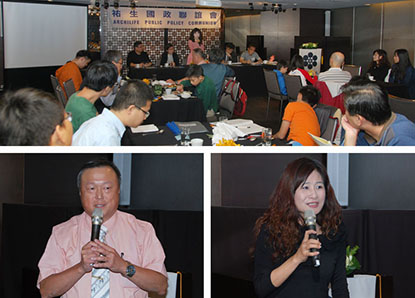 演講完畢,黃晉英秘書長代表基金會致贈謝禮予主講人。接著在與會者紛紛利用「餵豬時間」提出個人意見與看法互相交流後,圓滿地結束九月份國政聯誼會。 演講完畢,黃晉英秘書長代表基金會致贈謝禮予主講人。接著在與會者紛紛利用「餵豬時間」提出個人意見與看法互相交流後,圓滿地結束九月份國政聯誼會。After the speech, Secretary General Huang Chin-ying presented a gift to the speakers on behalf of the foundation. Then, attendees expressed and exchanged their opinions and views during the piggy hour. The October Archilife Public Policy Communion ended smoothly. |

